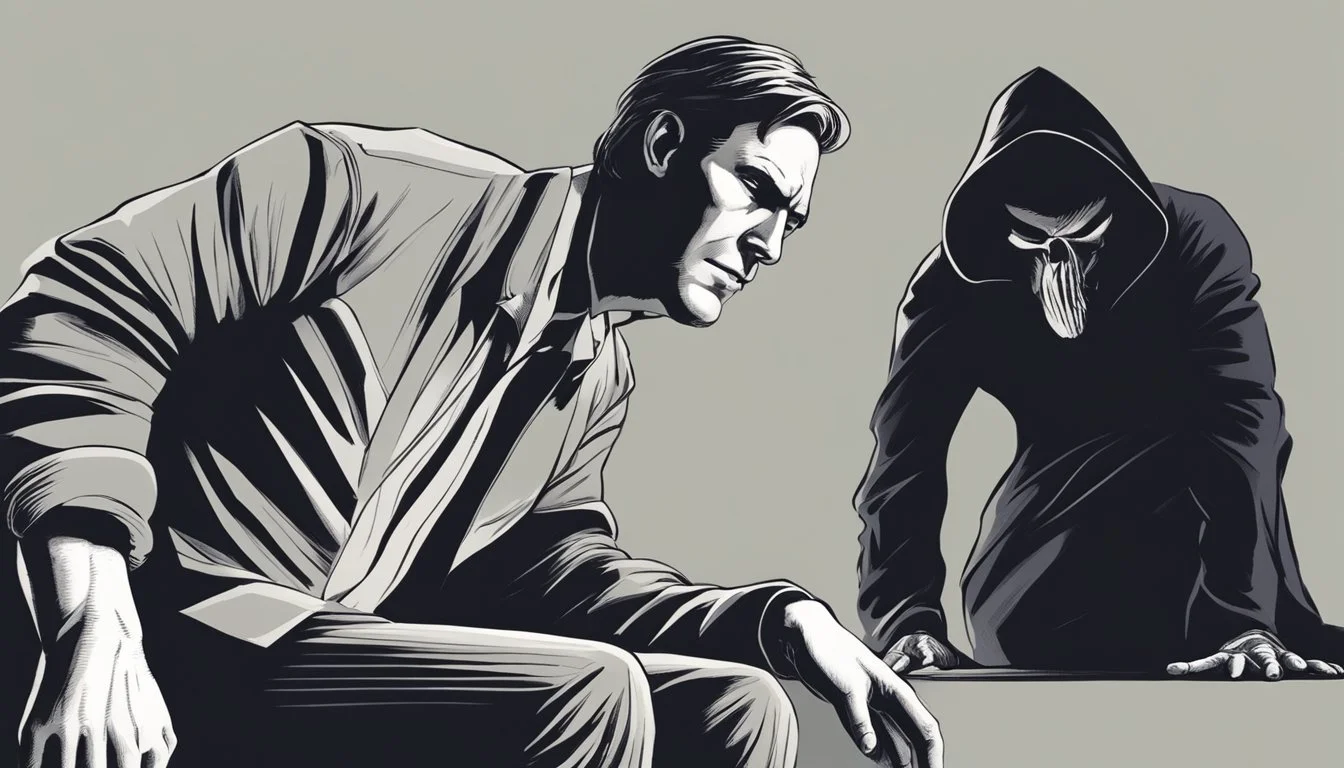Clifford Olson: 8 Manipulation Tactics Employed by Canada's Beast of B.C.
Analyzing the Methods of a Notorious Serial Killer
Clifford Olson, known as the "Beast of B.C.," was a Canadian serial killer who terrorized British Columbia in the early 1980s. His heinous crimes shocked the nation and left an indelible mark on Canadian criminal history. Olson's case became notorious not only for the brutal murders he committed but also for his manipulative behavior throughout the investigation and legal proceedings.
Olson's ability to manipulate those around him, including law enforcement and the justice system, was a defining aspect of his criminal career. From his initial interactions with police to his time in prison, Olson employed various tactics to gain advantages and exert control over others. Understanding these manipulation strategies provides insight into the mind of a serial killer and the challenges faced by those tasked with bringing such criminals to justice.
1) Gaining Trust Through Charm
Clifford Olson was known for his ability to gain trust through charm. He possessed a charismatic personality that allowed him to easily connect with people, especially his young victims.
Olson's friendly demeanor and engaging conversation skills made him appear harmless and trustworthy. He often presented himself as a helpful and kind individual, offering assistance or favors to those he targeted.
This manipulative tactic enabled Olson to lower people's defenses and create a false sense of security. By appearing likable and non-threatening, he was able to lure victims into vulnerable situations.
Olson's charm extended beyond his victims. He also used it to manipulate law enforcement and even negotiate his controversial "cash-for-bodies" deal. This deal allowed him to profit from revealing the locations of his victims' remains.
His ability to charm and persuade others played a significant role in his crimes. It allowed him to operate undetected for an extended period, highlighting the dangerous effectiveness of this manipulation tactic.
2) Feigning Innocence to Evade Suspicion
Clifford Olson employed the tactic of feigning innocence to evade suspicion during his criminal activities. He presented himself as a helpful citizen, often volunteering information to the police about his own crimes.
Olson's ability to act innocent allowed him to continue his killing spree undetected for an extended period. He would frequently contact the families of his victims, offering assistance in finding their missing loved ones.
This manipulation tactic served to both gather information about the investigations and deflect suspicion away from himself. By appearing cooperative and concerned, Olson managed to convince many that he could not possibly be involved in the crimes.
Law enforcement initially believed Olson's innocent act, which contributed to delays in his capture. His skill at feigning innocence enabled him to evade justice for eleven murders over the course of several months in 1981.
Olson's case demonstrates how criminals can exploit others' trust through false displays of innocence. It highlights the importance of critical evaluation of seemingly helpful individuals in criminal investigations.
3) Deploying Misdirection and Red Herrings
Clifford Olson skillfully employed misdirection and red herrings to confuse investigators and manipulate public perception. He often provided false leads and irrelevant information to divert attention from his crimes.
Olson would fabricate elaborate stories about his victims' whereabouts, sending authorities on wild goose chases. These tactics wasted valuable time and resources, hampering the investigation's progress.
He also planted misleading evidence at crime scenes to throw detectives off his trail. This included leaving items belonging to other individuals to implicate innocent people.
During interrogations, Olson frequently changed the subject or brought up unrelated topics. This strategy aimed to derail questioning and prevent investigators from uncovering crucial details about his crimes.
Olson's use of red herrings extended to his interactions with the media. He would make outlandish claims or provide sensational but false information to generate publicity and control the narrative surrounding his case.
By consistently deploying these deceptive tactics, Olson sought to maintain an upper hand in his interactions with law enforcement and the public. His skilled use of misdirection contributed to the challenges faced in bringing him to justice.
4) Employing Gaslighting Techniques
Clifford Olson utilized gaslighting techniques to manipulate his victims and evade capture. He frequently denied his actions, causing others to question their own perceptions and memories.
Olson minimized the severity of his crimes, attempting to make authorities and victims' families doubt the gravity of the situation. He would present alternative explanations for events, sowing confusion and uncertainty.
The serial killer often shifted blame onto others, including his victims, to deflect attention from himself. This tactic aimed to make people question their judgments and second-guess their suspicions about him.
Olson exploited societal norms and expectations to his advantage. He presented himself as a normal, upstanding citizen, making it difficult for others to reconcile his public persona with his heinous acts.
By consistently lying and manipulating facts, Olson created an alternate reality that served his purposes. This persistent gaslighting made it challenging for law enforcement and the public to uncover the truth about his crimes.
5) Manipulating Media Narratives
Clifford Olson strategically manipulated media narratives to maintain control over his public image. He frequently reached out to journalists, offering exclusive interviews and information about his crimes.
Olson used these opportunities to present himself as an intelligent and charismatic figure. He crafted a persona that was both intriguing and repulsive to the public, ensuring ongoing media coverage.
By selectively revealing details about his crimes, Olson kept the media and public engaged. He would often promise new revelations, only to withhold information at the last moment.
This tactic allowed him to remain in the spotlight and exert influence over how his story was told. Olson understood that media attention could be leveraged for personal gain and notoriety.
He exploited the media's appetite for sensational stories, playing different outlets against each other. This manipulation extended the duration of his infamy and allowed him to shape public perception to some degree.
Olson's ability to manipulate media narratives demonstrated his understanding of public communication and psychological tactics. It showcased his cunning nature and desire for attention, even while incarcerated.
6) Exploiting Legal Loopholes
Clifford Olson demonstrated a keen ability to exploit legal loopholes throughout his criminal career and subsequent incarceration. He manipulated the justice system to his advantage on multiple occasions.
One of Olson's most notorious tactics involved the controversial "cash-for-bodies" deal. He negotiated an agreement with authorities, offering information about his victims' locations in exchange for payments to his family.
This arrangement sparked public outrage and debates about the ethics of paying criminals for information. Olson's exploitation of this legal gray area allowed him to secure financial benefits while already facing life imprisonment.
During his time in custody, Olson continued to find ways to manipulate the system. He filed numerous frivolous lawsuits and complaints, exploiting legal processes to gain attention and disrupt prison operations.
Olson also attempted to use legal channels to obtain early release or improved conditions. He made repeated parole applications, despite having no realistic chance of release, forcing victims' families to relive their trauma.
His actions highlighted vulnerabilities in the legal system and prompted discussions about necessary reforms to prevent similar exploitation by other offenders in the future.
7) Utilizing Fear and Intimidation
Clifford Olson employed fear and intimidation as key tactics in his criminal activities. He used threats of violence to control his victims and prevent them from seeking help or escaping.
Olson's imposing physical presence and aggressive demeanor instilled terror in those he targeted. He often brandished weapons to heighten the sense of danger and maintain dominance over his victims.
The serial killer exploited his victims' vulnerabilities, preying on their fears and insecurities. He manipulated their emotions by alternating between acts of kindness and sudden outbursts of rage.
Olson's reputation for brutality preceded him, creating an atmosphere of dread even before direct encounters. This psychological warfare helped him maintain control over potential witnesses and accomplices.
By cultivating an aura of unpredictability, Olson kept his victims in a constant state of anxiety. This tactic effectively paralyzed them with fear, making resistance or escape seem impossible.
The Beast of B.C. also used intimidation tactics against law enforcement and the justice system. He attempted to manipulate investigations and legal proceedings through threats and false information.
8) Crafting a False Sense of Security
Clifford Olson employed deceptive tactics to create a false sense of security among his victims. He often presented himself as a trustworthy figure, such as a police officer or a concerned adult.
Olson's manipulation skills allowed him to gain the confidence of both children and their parents. He would use friendly conversation and charm to disarm potential suspicions.
By appearing helpful and non-threatening, Olson lured victims into vulnerable situations. He might offer rides or assistance, exploiting the natural trust children often have in adults.
Olson's ability to craft this illusion of safety was a key factor in his crimes. He understood how to exploit social norms and expectations to his advantage.
This tactic demonstrates the importance of teaching children about stranger danger and trusting their instincts. It also highlights the need for communities to be vigilant and protective of their most vulnerable members.
Background of Clifford Olson
Clifford Robert Olson Jr. was a notorious Canadian serial killer who gained infamy for his horrific crimes in the early 1980s. His troubled past and extensive criminal history set the stage for his eventual descent into murder.
Early Life
Born on January 1, 1940, Clifford Olson grew up in Vancouver, British Columbia. He displayed behavioral problems from a young age, frequently getting into trouble at school and with law enforcement. Olson's childhood was marked by instability and a lack of proper guidance.
His parents struggled to control his disruptive behavior, leading to multiple encounters with juvenile authorities. By his teenage years, Olson had already begun engaging in petty crimes and showing signs of antisocial tendencies.
Criminal History
Olson's criminal career began in earnest during his late teens and early twenties. He committed a wide range of offenses, including theft, fraud, and sexual assault. His record grew steadily over the years, with frequent arrests and incarcerations.
By the 1970s, Olson had become a seasoned criminal, adept at manipulating the justice system. He often acted as an informant to gain favorable treatment. In 1976, while serving a sentence for fraud, Olson shared a cell with Gary Francis Marcoux, further exposing him to criminal influences.
Olson's crimes escalated in severity over time. His history of sexual assaults foreshadowed the horrific murders he would later commit. By 1981, Olson had transformed from a career criminal into one of Canada's most infamous serial killers.
Psychological Profile
Clifford Olson exhibited severe antisocial and psychopathic tendencies that fueled his heinous crimes. His psychological makeup was characterized by a lack of empathy, manipulative behavior, and a constant need for stimulation.
Personality Traits
Olson displayed classic traits of psychopathy. He was superficially charming and glib, using his charisma to manipulate others. His grandiose sense of self-worth was evident in his interactions with law enforcement and the media.
Olson lacked empathy and remorse for his victims. This emotional detachment allowed him to commit brutal acts without hesitation.
He was impulsive and prone to boredom, constantly seeking new thrills and stimulation. This trait likely contributed to his escalating criminal behavior over time.
Olson exhibited pathological lying, effortlessly deceiving others to achieve his goals. His manipulative nature extended to both his victims and the justice system.
Behavior Patterns
Olson's criminal history revealed a pattern of escalating violence. He progressed from theft and fraud to sexual assaults and ultimately murder.
He demonstrated predatory behavior, carefully selecting vulnerable victims. Olson often targeted young people, exploiting their trust and naivety.
His crimes showed signs of meticulous planning mixed with opportunistic actions. Olson would sometimes stalk potential victims before striking.
He displayed a need for control and power over his victims. This manifested in his sadistic acts and his later attempts to manipulate the justice system for personal gain.
Olson's behavior in prison and during trials indicated a constant desire for attention and notoriety. He seemed to revel in his infamy, further highlighting his psychopathic tendencies.
Impact on Canadian Law
Clifford Olson's crimes led to significant changes in Canadian legal and criminal justice practices. These reforms aimed to address shortcomings exposed by his case and improve support for victims' families.
Legal Reforms
The Olson case prompted a reevaluation of victim rights in Canada. In 1988, the government introduced the Victims of Crime Act, establishing basic principles for the treatment of victims. This legislation ensured victims received information about the justice process and offender status.
The controversial "cash-for-bodies" deal used to locate Olson's victims sparked debate about plea bargaining. It led to stricter guidelines on negotiations with suspects and increased scrutiny of deals offered by prosecutors.
Olson's crimes also influenced changes to the Criminal Code. Amendments were made to strengthen penalties for crimes against children and expand police investigative powers in missing persons cases.
Public Perception
The Olson case deeply affected public trust in the justice system. Many Canadians were outraged by the payment made to Olson and felt the system prioritized the offender over victims.
This shift in perception led to increased advocacy for victims' rights. Support groups and organizations emerged, pushing for greater involvement of victims in the legal process.
The case also sparked a national conversation about the death penalty, which had been abolished in Canada in 1976. Some called for its reinstatement in response to Olson's crimes.
Media coverage of the case raised awareness about child safety. Parents became more vigilant, and schools implemented new security measures to protect students.








